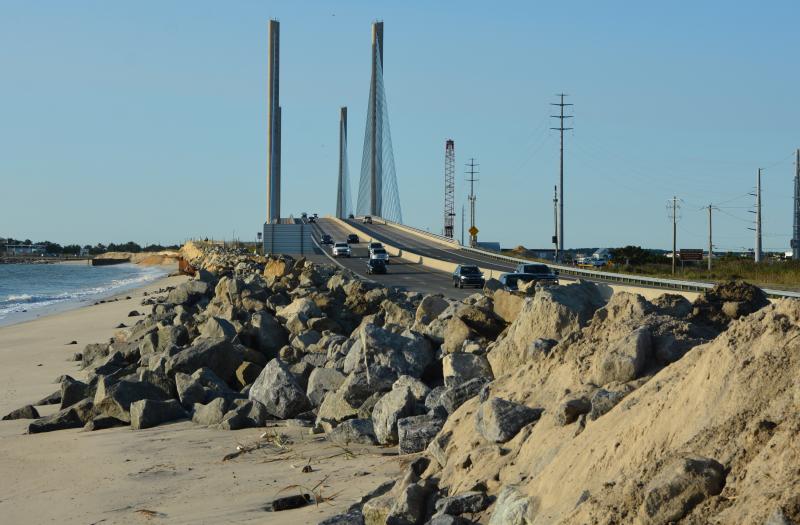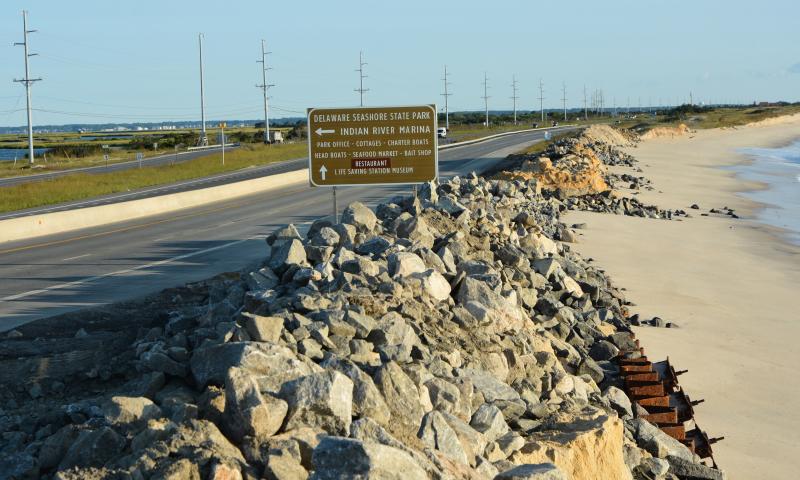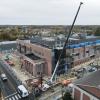State taking new approach on Route 1 dune breaches
In response to recent breaches, and in anticipation of more in the future, the state is taking a different approach to hardening the sand dune along Route 1 immediately north of the Indian River Inlet – instead of truckloads of sand, truckloads of riprap are being used.
The Delaware Department of Natural Resources and Environmental Control does not typically use hardened shoreline remedies, but a joint decision was made with the Delaware Department of Transportation to use the riprap because of the immediate urgency of the situation to protect critical highway infrastructure, said Michael Globetti, DNREC spokesperson.
For the second time since March, a significant storm caused ocean waves to breach the dune immediately north of the inlet Aug. 18, which forced the northbound lanes of Route 1 to be closed for an extended period of time.
DelDOT has placed approximately 100 truckloads, more than 12,200 tons, of riprap at the site in anticipation of the breach problem recurring, said Globetti.
In addition to the larger rock material, sand is also being trucked in to build the dune back up, said Globetti, adding that this collaboration has been ongoing for several weeks and will continue for the near future. Different options exist for more stone to be placed at the most weakened section of the dune, and it’s a topic that will be evaluated by senior leadership of both agencies on the back side of the hurricane season, he said.
DNREC traditionally opts for strategies that work with the natural processes of coastal systems, such as dune restoration and beach nourishment, rather than relying on hardened structures, said Globetti. This approach aims to preserve the natural balance of coastal environments, maintain ecological health and provide long-term, adaptable protection against coastal hazards, he said.
“Hardening shorelines can disrupt these natural processes, reduce access to vital habitat, alter natural sediment distribution and also increase long-term maintenance costs,” said Globetti.
For at least the immediate future, the state park’s public parking lot on the north side of the inlet has been closed because of the large equipment needed to work on the dune.
For the safety of both DNREC staff and visitors, it was deemed prudent to close the lot during dune-repair construction activities, because the heavy equipment moving about the area has large blind spots and slow stopping capabilities, said Globetti.
“Sand, along with rock material, will be arriving continuously during the DNREC-DelDOT dune-repair partnership,” said Globetti. “The immediate goal of the project is to protect critical infrastructure, with a long-term goal of restoring the beach area for recreational use and the functionality of the dune system as quickly as possible.”
While the beach on the north side of the inlet hasn’t been officially closed by DNREC, Globetti said that stretch of beach will be an active construction zone for the next several months, and the agency is asking that visitors avoid the area while the heavy equipment is being used. Work will be focused from 6 a.m. to 3 p.m., Monday through Thursday, unless there is a critical need for work outside of regularly scheduled project dates, he said.
In addition to the dune breach, large pieces of debris from the old roadway continue to wash ashore.
There is still a lot of debris just offshore that DNREC’s equipment cannot reach, and efforts are underway to secure the required specialized equipment so it can be removed, said Globetti.
Looking toward the future, Globetti said DNREC has been working on a large-scale nourishment project for this area since 2023 and is now actively working to expedite its implementation given the recent dune breaches. Much of the project will utilize the return of the sand bypass system at the inlet, which is currently being repowered and expected to be back online by December, he said.




















































